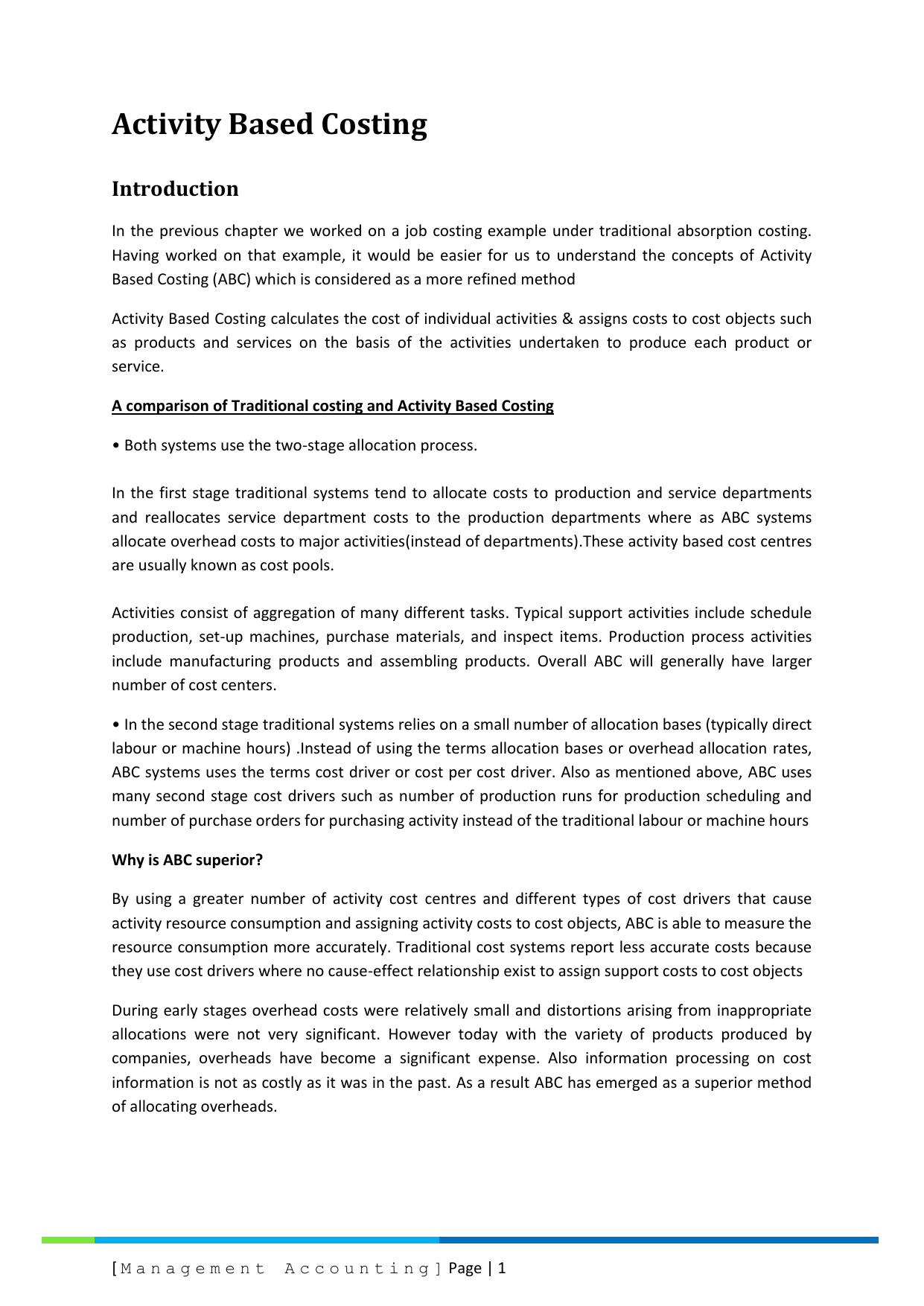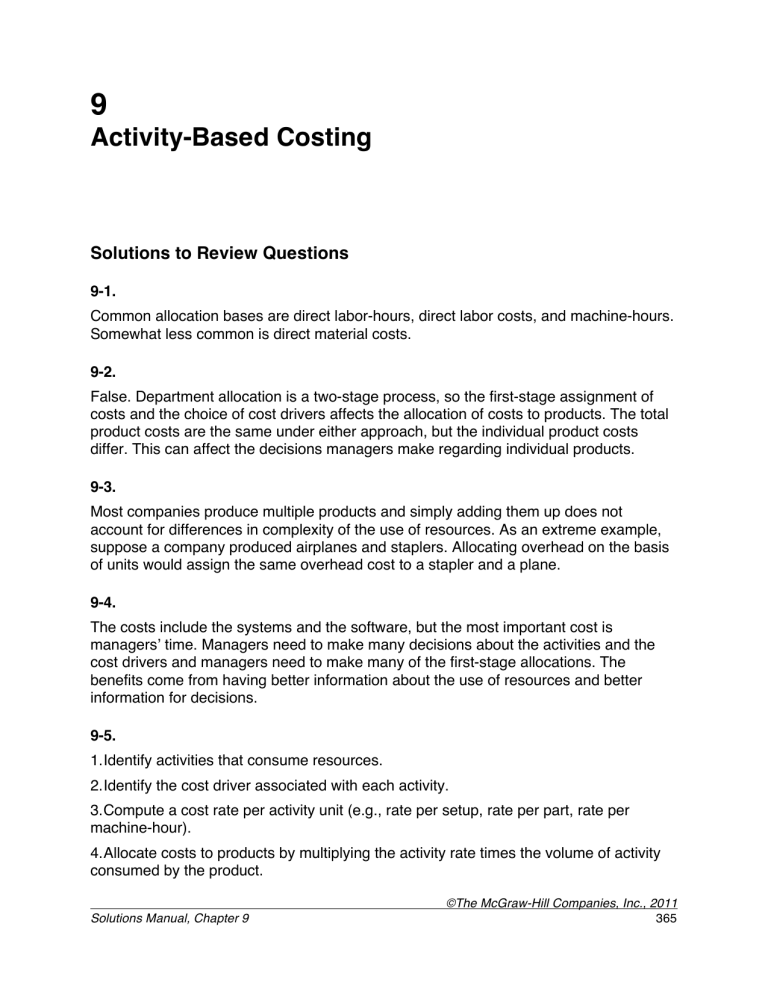The Different Between Traditional Cost Allocation Method And Abc
Compare ABC and traditional methods of overhead absorption based on production units labour hours or machine hours. Activity Based Costing ABC is one of several approaches to job costing.

What Is Activity Based Costing Abc Accounting Hub
Activity-based costing is a comprehensive cost allocation method.

The different between traditional cost allocation method and abc. ABC is more complex and more accurate than traditional costing. What are the pros and cons of both ABC and traditional cost allocation. It adds fixed overhead costs to the variable costs.
Irrespective of the specific allocation of resources traditional costing. Both methods estimate overhead costs related to production and then assign these costs to products based on a cost-driver rate. Traditional cost allocation Production volume-based allocating 425.
The assumption for ABC is that activities consume resources and products consume activities. Traditional absorption costing Traditional absorption costing assumes that overhead expenditure is related to direct labour hours machine hours or production units. Traditional costing shows product A more profitable than product B.
In the TCA system the cost objects and used up resources are required to evaluate the. Overview and Key Difference 2. A comparison of the overhead per unit calculated using the ABC and traditional methods often shows very different results.
ABC is that costing in which costs are. What is Absorption Costing 3. Activity-based costing has pros and cons.
Difference is occurring in the complexity and accuracy. However this assumption is no longer reliable in many companies. Assigns overhead costs more accurately to products than simpler costing methods.
Figure 1 shows the process of cost allocation under traditional costing using the product as the cost object. The key difference between absorption costing and activity based costing is that while absorption costing is a way of allocating all costs to individual production units activity based costing is a way of using multiple cost drivers to allocate costs. In the traditional system a few allocation bases are used to allocate overhead costs whereas ABC system uses many drivers as allocation basis.
In the accounting field traditional costing and ABC are two main and different methods used for cost allocation to products. ABC method serves several purposes including product costing pricing profitability and customer profitability analysis. The differences are in the accuracy and complexity of the two methods.
Give reasons to support your statements. The primary focus of traditional costing is the apportionment of overhead costs to the activities of production. In the field of accounting activity-based costing and traditional costing are two different methods for allocating indirect costs to products.
According to Zelman McCue Glick and Thomas 2014 activity-based costing ABC requires increased attention as compared to traditional top-down cost-allocation methods. Write your initial response in approximately 300500 words. The main points of difference between activity based costing and traditional costing are given below.
Traditionally job costing has been measured by allocating all direct costs associated with a certain job as well as a fair share usually based on direct labour hours or volume of the total indirect costsoverheads incurred across all product lines. Traditional allocation assigns costs as period or product costs and all product costs are included in the cost of inventory which makes this method acceptable for generally accepted accounting principles GAAP. In your opinion is the ABC method better than traditional cost-allocation methods.
In both methods overhead costs are estimated according to production and then with the help of cost drivers assign these costs. Differences between activity based costing and traditional costing. Traditional costing is easy to implement and is the most common costing method used.
ABC based costing shows the reverse. Traditional method allocates overheads first to the individual departments whereas activity based costing assigns over heads to each activity first. Traditional allocation is optimal when the manufacturing process is labor driven and overhead increases based on traditional activity bases such as direct labor hours direct labor dollars or machine.
Traditional costing is more simplistic and less accurate than ABC and typically assigns overhead costs to products based on an arbitrary average rate. BASIS OF DIFFERENCE. These differences result from the different treatment of overhead.
Traditional costing will have one rate for allocation of overhead for the entire business operation while activity-based absorption costing creates multiple cost pools. There are two significant differences between traditional costing and ABC. What is the difference between ABC and traditional costing.
The differences are in the accuracy and complexity of the two methods. The ABC system can be extremely complicated and difficult to implement. Traditional costing is the allocation of factory overhead to products based on the volume of production resources consumed.
The difference between ABC or Activity Based Costing and TCA or Traditional Cost Accounting is that ABC is complex whereas TCA is simple. In this example the overhead charged to the hollow ball using ABC is 052 and much higher than the 035 calculated under the traditional method. The assumption for ABC is that activities consume resources and products consume activities.
Traditional Costing Use one single plant wide or department. Comparing profitability estimates from two different costing methods. Ad Various Alternate Hierarchies Created Maintained Quickly In Dimension User Interface.
Think It Through ABC Method and Financial Statements There are pros and cons to both the traditional and the ABC system. The ABC system began in 1981 whereas TCA methods were designed and developed between 1870 to 1920. The difference between traditional cost behavior and Activity-based costing ABC is traditional cost behavior divides cost into variable and fixed categories while Activity-based costing ABC divides the costs into those that vary with unit-level activities batch-level activities and facility-level costs.
Cost Pools Traditional costing uses cost centres as cost pools and allocates indirect costs to a cost object through those cost centres. Discuss the differences between the ABC method and traditional cost allocation. According to Zelman McCue Glick and Thomas 2014 activity-based costing ABC requires increased attention as compared to traditional top-down cost-allocation methods.
ABC vs Traditional Costing. Activity Based costing approach. On the other hand absorption costing is the conventional costing approach.
ACTIVITY BASED COSTING. ABC Costing Uses multiple allocation bases. Equally the assumption is that if you can control activities or processes then you can also.
Discuss the differences between the ABC method and traditional cost allocation. Traditional costing is more simple method as compare to ABC and. It helps the management identify cost activities and cost drivers.
Why or why not. The Activity-Based Costing ABC is a costing system which focuses on activities performed to produce Products. Traditional allocation assigns overhead based on a single overhead rate while ABC assigns overhead based on several cost pools and the activities that drive costs.

Difference Between Activity Base Costing And Traditional Costing

How To Calculate Interest Compounding For Exponential Growth Exponential Exponential Growth Finance

Pdf Costing Models A Comparison

Activity Based Costing Everything You Need To Know About The Abc Methodology Myabcm


Posting Komentar untuk "The Different Between Traditional Cost Allocation Method And Abc"